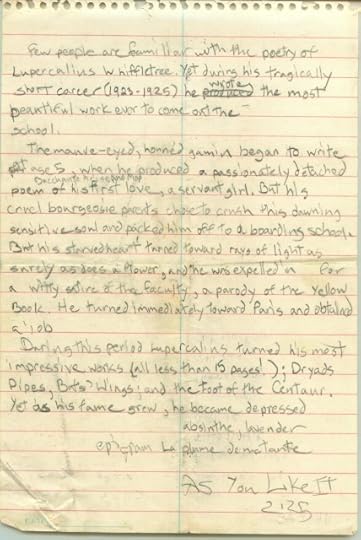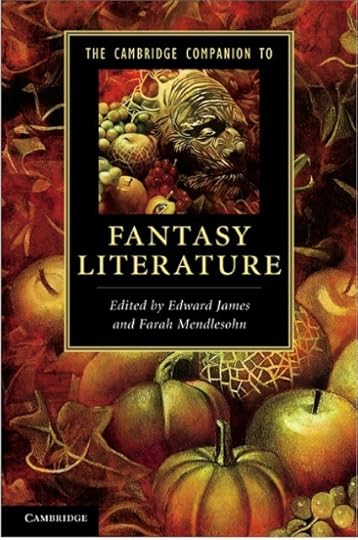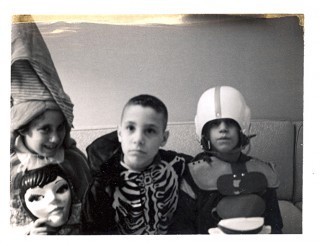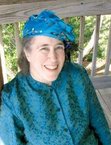Greer Gilman's Blog, page 88
July 5, 2011
"Fortunatus et ille..."
From an old sketchbook, a faun:
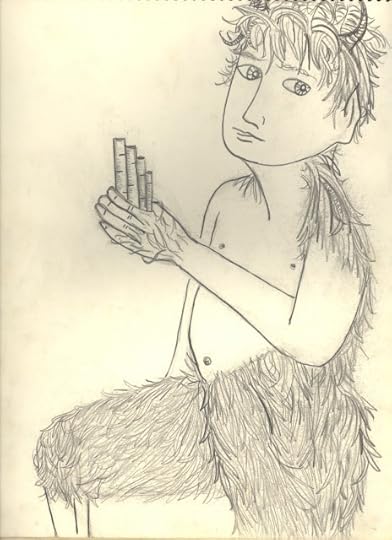
I can't remember if I meant this for Mr. Tumnus, or if I were trying (in all innocence) to be Aubrey Beardsley. I must have been about fifteen.
Nine

I can't remember if I meant this for Mr. Tumnus, or if I were trying (in all innocence) to be Aubrey Beardsley. I must have been about fifteen.
Nine
Published on July 05, 2011 17:38
July 4, 2011
Bacchante, Arise and Mop!
Published on July 04, 2011 12:35
July 1, 2011
Lunasadh for geeks
My Readercon schedule, gods willing:
Friday July 15
1:00 PM ME The Readercon New Fiction Book Club: Among Others. Suzy Charnas, Gwynne Garfinkle, Greer Gilman, Madeleine Robins (leader), Gary K. Wolfe.
Jo Walton's stand-alone contemporary novel Among Others scatters several familiar fantasy concepts--the epistolary diary narrative, the British boarding school, countryside faeries, an evil mother, the magic of twins, and even a hint of Arthuriana--over a battered industrial landscape amid passionate paeans to classic science fiction and fannish community. The resulting tale has an almost slipstreamish unease; though set in the 1970s, it could only have been written in the early 21st century. We will discuss the ways Walton combines and contrasts these very disparate elements as well as the concepts of audience implied by the novel's thorough anchoring in a particular time and place.
5:00 PM VT Reading. Greer Gilman. Gilman reads from a work in progress.
7:00 PM ME The Quest and the Rest. Greer Gilman, M.C.A. Hogarth, Kelly Link, Robert V.S. Redick, Madeleine Robins (leader).
In a 1951 letter, J.R.R. Tolkien wrote that Samwise and Rosie's romance, though understated, "is absolutely essential to... the relation of ordinary life (breathing, eating, working, begetting) and quests, sacrifice, causes." Works as varied as Lois Bujold's Vorkosigan series, Stephen King's Lisey's Story, and Gail Carriger's Parasol Protectorate novels overtly interweave speculative elements with themes such as love, marriage, parenthood, and holding down a steady job. Does the mundanity of responsible adulthood interfere with escapism, or are readers thrilled to have protagonists they can identify with? How do different authors and narratives handle the tension between the intimate and ordinary and the vast and mysterious?
Saturday July 16
2:00 PM F Location as Character. Greer Gilman, Glenn Grant, Elizabeth Hand (leader), Michael Aondo-verr Kombol, Yves Meynard, Madeleine Robins.
We can read certain authors whose mere invocation of a previously described location adds a level of depth to the story, such as Lovecraft's Innsmouth or Elizabeth Hand's Kamensic. The idea of fictional locations as characters in their own right is one that has been explored many times before, so let's talk about the techniques and reasons for doing so. The reasons for an author to re-use a locale seem fairly obvious, but are there reasons not to do so? What are some of the challenges in describing a reality-based location powerfully enough to transport a reader? Panelists will discuss their favorite scene-setting techniques, as well as locations in other writer's works that have felt real and solid for them.
.
Sunday July 17
1:00 PM F I Know What I Like: The Artistic Tastes of Characters. Greer Gilman, Geary Gravel, Resa Nelson, Margaret Ronald, Sonya Taaffe (leader).
Exploring the artistic tastes of characters can lead to interesting and subtle exposition of personality--or be a ham-fisted shortcut that reinforces stereotypes. Talking about art also expands the setting of a story, as all art is an expression of culture. What are some of the pitfalls of approaching a character from this angle and how do you avoid them?
2:00 PM ME The Languages of the Fantastic. Greer Gilman.
Works of fantasy can make unusual narrative demands. Their writers may need to call forth spirits from the vasty deep; or convincingly record a dialogue of dragons; or invent the tongues of angels and of orcs. Greer Gilman looks at the many strategies of style by which illusion is created and upheld: the grammar of the elsewhere and the otherwise. Her essay on "The Languages of the Fantastic" will appear in The Cambridge Companion to Fantasy Literature (edited by Farah Mendlesohn and Edward James).
Nine
Friday July 15
1:00 PM ME The Readercon New Fiction Book Club: Among Others. Suzy Charnas, Gwynne Garfinkle, Greer Gilman, Madeleine Robins (leader), Gary K. Wolfe.
Jo Walton's stand-alone contemporary novel Among Others scatters several familiar fantasy concepts--the epistolary diary narrative, the British boarding school, countryside faeries, an evil mother, the magic of twins, and even a hint of Arthuriana--over a battered industrial landscape amid passionate paeans to classic science fiction and fannish community. The resulting tale has an almost slipstreamish unease; though set in the 1970s, it could only have been written in the early 21st century. We will discuss the ways Walton combines and contrasts these very disparate elements as well as the concepts of audience implied by the novel's thorough anchoring in a particular time and place.
5:00 PM VT Reading. Greer Gilman. Gilman reads from a work in progress.
7:00 PM ME The Quest and the Rest. Greer Gilman, M.C.A. Hogarth, Kelly Link, Robert V.S. Redick, Madeleine Robins (leader).
In a 1951 letter, J.R.R. Tolkien wrote that Samwise and Rosie's romance, though understated, "is absolutely essential to... the relation of ordinary life (breathing, eating, working, begetting) and quests, sacrifice, causes." Works as varied as Lois Bujold's Vorkosigan series, Stephen King's Lisey's Story, and Gail Carriger's Parasol Protectorate novels overtly interweave speculative elements with themes such as love, marriage, parenthood, and holding down a steady job. Does the mundanity of responsible adulthood interfere with escapism, or are readers thrilled to have protagonists they can identify with? How do different authors and narratives handle the tension between the intimate and ordinary and the vast and mysterious?
Saturday July 16
2:00 PM F Location as Character. Greer Gilman, Glenn Grant, Elizabeth Hand (leader), Michael Aondo-verr Kombol, Yves Meynard, Madeleine Robins.
We can read certain authors whose mere invocation of a previously described location adds a level of depth to the story, such as Lovecraft's Innsmouth or Elizabeth Hand's Kamensic. The idea of fictional locations as characters in their own right is one that has been explored many times before, so let's talk about the techniques and reasons for doing so. The reasons for an author to re-use a locale seem fairly obvious, but are there reasons not to do so? What are some of the challenges in describing a reality-based location powerfully enough to transport a reader? Panelists will discuss their favorite scene-setting techniques, as well as locations in other writer's works that have felt real and solid for them.
.
Sunday July 17
1:00 PM F I Know What I Like: The Artistic Tastes of Characters. Greer Gilman, Geary Gravel, Resa Nelson, Margaret Ronald, Sonya Taaffe (leader).
Exploring the artistic tastes of characters can lead to interesting and subtle exposition of personality--or be a ham-fisted shortcut that reinforces stereotypes. Talking about art also expands the setting of a story, as all art is an expression of culture. What are some of the pitfalls of approaching a character from this angle and how do you avoid them?
2:00 PM ME The Languages of the Fantastic. Greer Gilman.
Works of fantasy can make unusual narrative demands. Their writers may need to call forth spirits from the vasty deep; or convincingly record a dialogue of dragons; or invent the tongues of angels and of orcs. Greer Gilman looks at the many strategies of style by which illusion is created and upheld: the grammar of the elsewhere and the otherwise. Her essay on "The Languages of the Fantastic" will appear in The Cambridge Companion to Fantasy Literature (edited by Farah Mendlesohn and Edward James).
Nine
Published on July 01, 2011 14:56
June 25, 2011
Lunasadh for geeks
My Readercon schedule, gods willing:
Friday July 15
1:00 PM ME The Readercon New Fiction Book Club: Among Others. Suzy Charnas, Gwynne Garfinkle, Greer Gilman, Madeleine Robins (leader), Gary K. Wolfe.
Jo Walton's stand-alone contemporary novel Among Others scatters several familiar fantasy concepts--the epistolary diary narrative, the British boarding school, countryside faeries, an evil mother, the magic of twins, and even a hint of Arthuriana--over a battered industrial landscape amid passionate paeans to classic science fiction and fannish community. The resulting tale has an almost slipstreamish unease; though set in the 1970s, it could only have been written in the early 21st century. We will discuss the ways Walton combines and contrasts these very disparate elements as well as the concepts of audience implied by the novel's thorough anchoring in a particular time and place.
5:00 PM VT Reading. Greer Gilman. Gilman reads from a work in progress.
7:00 PM ME The Quest and the Rest. Greer Gilman, M.C.A. Hogarth, Kelly Link, Robert V.S. Redick, Madeleine Robins (leader).
In a 1951 letter, J.R.R. Tolkien wrote that Samwise and Rosie's romance, though understated, "is absolutely essential to... the relation of ordinary life (breathing, eating, working, begetting) and quests, sacrifice, causes." Works as varied as Lois Bujold's Vorkosigan series, Stephen King's Lisey's Story, and Gail Carriger's Parasol Protectorate novels overtly interweave speculative elements with themes such as love, marriage, parenthood, and holding down a steady job. Does the mundanity of responsible adulthood interfere with escapism, or are readers thrilled to have protagonists they can identify with? How do different authors and narratives handle the tension between the intimate and ordinary and the vast and mysterious?
Saturday July 16
1:00 PM RI The Languages of the Fantastic. Greer Gilman.
Works of fantasy can make unusual narrative demands. Their writers may need to call forth spirits from the vasty deep; or convincingly record a dialogue of dragons; or invent the tongues of angels and of orcs. Greer Gilman looks at the many strategies of style by which illusion is created and upheld: the grammar of the elsewhere and the otherwise. Her essay on "The Languages of the Fantastic" will appear in The Cambridge Companion to Fantasy Literature (edited by Farah Mendlesohn and Edward James).
2:00 PM F Location as Character. Greer Gilman, Glenn Grant (leader), Elizabeth Hand, Michael Aondo-verr Kombol, Yves Meynard, Madeleine Robins.
We can read certain authors whose mere invocation of a previously described location adds a level of depth to the story, such as Lovecraft's Innsmouth or Elizabeth Hand's Kamensic. The idea of fictional locations as characters in their own right is one that has been explored many times before, so let's talk about the techniques and reasons for doing so. The reasons for an author to re-use a locale seem fairly obvious, but are there reasons not to do so? What are some of the challenges in describing a reality-based location powerfully enough to transport a reader? Panelists will discuss their favorite scene-setting techniques, as well as locations in other writer's works that have felt real and solid for them.
Sunday July 17
1:00 PM F I Know What I Like: The Artistic Tastes of Characters. Greer Gilman, Geary Gravel, Eugene Mirabelli (leader), Margaret Ronald, Sonya Taaffe.
Exploring the artistic tastes of characters can lead to interesting and subtle exposition of personality--or be a ham-fisted shortcut that reinforces stereotypes. Talking about art also expands the setting of a story, as all art is an expression of culture. What are some of the pitfalls of approaching a character from this angle and how do you avoid them?
Nine
Friday July 15
1:00 PM ME The Readercon New Fiction Book Club: Among Others. Suzy Charnas, Gwynne Garfinkle, Greer Gilman, Madeleine Robins (leader), Gary K. Wolfe.
Jo Walton's stand-alone contemporary novel Among Others scatters several familiar fantasy concepts--the epistolary diary narrative, the British boarding school, countryside faeries, an evil mother, the magic of twins, and even a hint of Arthuriana--over a battered industrial landscape amid passionate paeans to classic science fiction and fannish community. The resulting tale has an almost slipstreamish unease; though set in the 1970s, it could only have been written in the early 21st century. We will discuss the ways Walton combines and contrasts these very disparate elements as well as the concepts of audience implied by the novel's thorough anchoring in a particular time and place.
5:00 PM VT Reading. Greer Gilman. Gilman reads from a work in progress.
7:00 PM ME The Quest and the Rest. Greer Gilman, M.C.A. Hogarth, Kelly Link, Robert V.S. Redick, Madeleine Robins (leader).
In a 1951 letter, J.R.R. Tolkien wrote that Samwise and Rosie's romance, though understated, "is absolutely essential to... the relation of ordinary life (breathing, eating, working, begetting) and quests, sacrifice, causes." Works as varied as Lois Bujold's Vorkosigan series, Stephen King's Lisey's Story, and Gail Carriger's Parasol Protectorate novels overtly interweave speculative elements with themes such as love, marriage, parenthood, and holding down a steady job. Does the mundanity of responsible adulthood interfere with escapism, or are readers thrilled to have protagonists they can identify with? How do different authors and narratives handle the tension between the intimate and ordinary and the vast and mysterious?
Saturday July 16
1:00 PM RI The Languages of the Fantastic. Greer Gilman.
Works of fantasy can make unusual narrative demands. Their writers may need to call forth spirits from the vasty deep; or convincingly record a dialogue of dragons; or invent the tongues of angels and of orcs. Greer Gilman looks at the many strategies of style by which illusion is created and upheld: the grammar of the elsewhere and the otherwise. Her essay on "The Languages of the Fantastic" will appear in The Cambridge Companion to Fantasy Literature (edited by Farah Mendlesohn and Edward James).
2:00 PM F Location as Character. Greer Gilman, Glenn Grant (leader), Elizabeth Hand, Michael Aondo-verr Kombol, Yves Meynard, Madeleine Robins.
We can read certain authors whose mere invocation of a previously described location adds a level of depth to the story, such as Lovecraft's Innsmouth or Elizabeth Hand's Kamensic. The idea of fictional locations as characters in their own right is one that has been explored many times before, so let's talk about the techniques and reasons for doing so. The reasons for an author to re-use a locale seem fairly obvious, but are there reasons not to do so? What are some of the challenges in describing a reality-based location powerfully enough to transport a reader? Panelists will discuss their favorite scene-setting techniques, as well as locations in other writer's works that have felt real and solid for them.
Sunday July 17
1:00 PM F I Know What I Like: The Artistic Tastes of Characters. Greer Gilman, Geary Gravel, Eugene Mirabelli (leader), Margaret Ronald, Sonya Taaffe.
Exploring the artistic tastes of characters can lead to interesting and subtle exposition of personality--or be a ham-fisted shortcut that reinforces stereotypes. Talking about art also expands the setting of a story, as all art is an expression of culture. What are some of the pitfalls of approaching a character from this angle and how do you avoid them?
Nine
Published on June 25, 2011 21:02
June 24, 2011
"...crimson grapes, tawny figs, raspberries of an emerald green..."
Published on June 24, 2011 23:05
June 23, 2011
A sweet hope of glory in my soul
Dearest to me of all the Watersons' unpagan songs. I played it ragged, and it got me through hard times.
What music there is in heaven this morning!
For Mike.
Nine
What music there is in heaven this morning!
For Mike.
Nine
Published on June 23, 2011 10:05
June 22, 2011
For the very first time
O dear gods, not Mike Waterson! The sweetest man, with that jauntiness arising from a tough old life: early orphanhood, hard work, astounding music, and an earthfast family solidarity. Love and loss and instruments of joy. I remember his saying that their gypsy grandmother used to send the Waterson children out to gather mussels for dinner. (In Hull! It's a wonder they survived.) Mike wrote some of his best songs while plastering other folks' ceilings. Relentless work.
And that amazing voice, which Peter Bellamy called "dark yellow." So it is. At first hearing (if you don't do folk), it can be like a gulp of cod-liver oil. And when you've stopped spluttering and gasping, it's beautiful: that dark-prisoned sunlight, that depth of cold sea.
I'll push you in. Here's his electrifying Tam Lyn, the antidote to all twee fairydom. He tells the story as if for the very first time.
Here's his Three Day Millionaire. "Why, I left school Friday, started work on Saturday..."
And here the Waterson family sings Bright Phoebus at the Liverpool Philharmonic Hall on Friday 2 October 2009. For the very last time...
Nine
And that amazing voice, which Peter Bellamy called "dark yellow." So it is. At first hearing (if you don't do folk), it can be like a gulp of cod-liver oil. And when you've stopped spluttering and gasping, it's beautiful: that dark-prisoned sunlight, that depth of cold sea.
I'll push you in. Here's his electrifying Tam Lyn, the antidote to all twee fairydom. He tells the story as if for the very first time.
Here's his Three Day Millionaire. "Why, I left school Friday, started work on Saturday..."
And here the Waterson family sings Bright Phoebus at the Liverpool Philharmonic Hall on Friday 2 October 2009. For the very last time...
Nine
Published on June 22, 2011 11:34
June 20, 2011
I am sent with broom before...
Wishing all of you wondrous Midsummer Night's dreams.
Nine
Nine
Published on June 20, 2011 22:22
All in the morning betime
Valentines, in all innocence.



By teacher's law, you gave one to every other child in the class, beloved or not; so even I got twenty or thirty each year. I think they cost about a quarter a dozen, with an extra-special one for the teacher.
Nine



By teacher's law, you gave one to every other child in the class, beloved or not; so even I got twenty or thirty each year. I think they cost about a quarter a dozen, with an extra-special one for the teacher.
Nine
Published on June 20, 2011 21:46
Nine at seven, Hallows Eve
Published on June 20, 2011 21:10
Greer Gilman's Blog
- Greer Gilman's profile
- 42 followers
Greer Gilman isn't a Goodreads Author
(yet),
but they
do have a blog,
so here are some recent posts imported from
their feed.


